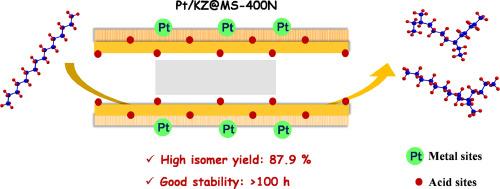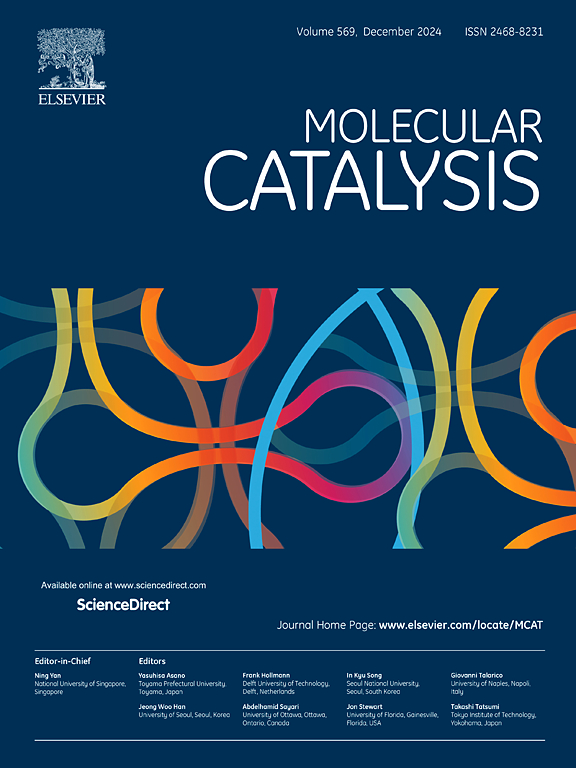通过设计具有部分堵塞微孔的核壳双功能催化剂促进正十六烷的加氢异构化
IF 4.9
2区 化学
Q2 CHEMISTRY, PHYSICAL
引用次数: 0
摘要
长链正构烷烃的加氢异构化是对化石燃料和润滑油进行升级以满足最新法规要求的一条不可或缺的途径。精确调节酸性和金属活性位点的分布以抑制不必要的裂解反应是迄今为止的一项艰巨任务。在这项工作中,我们开发了一种简单的涂覆-碳化策略,用于构建新型核壳双功能催化剂,该催化剂由具有部分堵塞通道的 ZSM-22 沸石核和负载在介孔二氧化硅壳上的铂纳米颗粒组成。这种独特的处理方法不仅调整了微孔通道和外表面酸位点的分布,还改变了铂纳米粒子的位置和分散。由于扩散长度短、酸位点与铂粒子之间的距离达到纳米级、金属分散度高,核壳双功能催化剂在正十六烷加氢异构化中表现出优异的性能,即异构化十六烷的产率达到 87.9%,与之前报道的铂/沸石催化剂相比属于较高水平。此外,该催化剂还具有出色的稳定性(100 小时内无失活现象)。所揭示的结构催化关系为设计长链正构烷烃加氢异构化的协同元酸活性位点提供了合理的参考。本文章由计算机程序翻译,如有差异,请以英文原文为准。

Boosting hydroisomerization of n-hexadecane by designing core-shell bifunctional catalysts with partially blocked micropores
Hydroisomerization of long-chain n-alkanes is an indispensable route for upgrading fossil fuels and lubricant oils to meet the state of art regulations. Precisely regulate the distribution of acidic and metal active sites to suppress unwanted cracking reaction is hitherto a difficult task. In this work, we develop a simple coating-carbonation strategy for constructing novel core-shell bifunctional catalysts, comprising ZSM-22 zeolite core with the partially blocked channels and Pt nanoparticles loaded on the mesoporous SiO2 shell. The unique treatment not only adjusted the distribution of acid sites located within the micropore channels and external surface, but also alter the locations and dispersion of Pt nanoparticles. Owing to the short diffusion lengths, nanoscale distance between acid sites and Pt species, and high metal dispersions, the core-shell bifunctional catalyst exhibits outperformed performance in n-hexadecane hydroisomerization, i.e., the yield of isomerized hexadecane can reach 87.9 %, which is among the relatively high level compared with the previous reported Pt/zeolite counterparts. Moreover, the catalyst also displays excellent stability (no deactivation within 100 h). The disclosed structure-catalysis relationship provides rational reference for designing the synergistic meta-acid active sites in the hydroisomerization of long-chain n-alkanes.
求助全文
通过发布文献求助,成功后即可免费获取论文全文。
去求助
来源期刊

Molecular Catalysis
Chemical Engineering-Process Chemistry and Technology
CiteScore
6.90
自引率
10.90%
发文量
700
审稿时长
40 days
期刊介绍:
Molecular Catalysis publishes full papers that are original, rigorous, and scholarly contributions examining the molecular and atomic aspects of catalytic activation and reaction mechanisms. The fields covered are:
Heterogeneous catalysis including immobilized molecular catalysts
Homogeneous catalysis including organocatalysis, organometallic catalysis and biocatalysis
Photo- and electrochemistry
Theoretical aspects of catalysis analyzed by computational methods
 求助内容:
求助内容: 应助结果提醒方式:
应助结果提醒方式:


